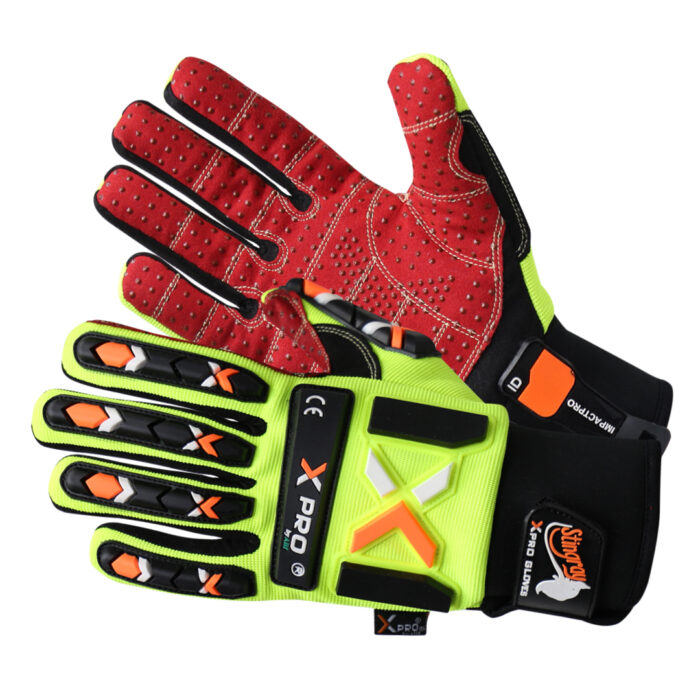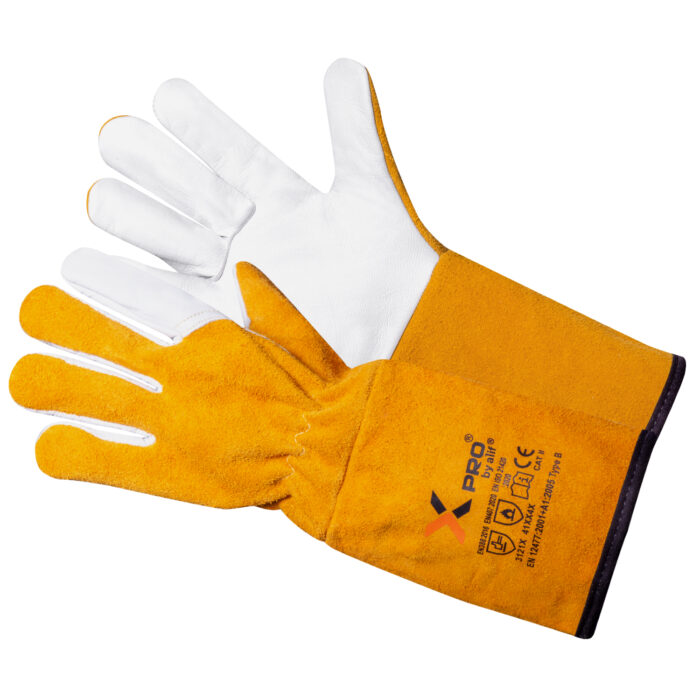XPRO® 3TGNLC6 Impact & Cut-Resistant Gloves – Cut level A6 Protection & Vibration Dampening for Industrial Work
Brand: XPRO®
XPRO® 3TGNLC6

Brand: XPRO®
XPRO® 3TGNLC6 Impact & Cut-Resistant Gloves – Cut level A6 Protection & Vibration Dampening for Industrial Work
XPRO® 3TGNLC6
Premium Goatskin leather has high strength and abrasion-resistant and referred to as natural strongest leather, fully lined with Kevlar® aramid fabric, cut level ANSI A6 protection. The back of hand and fingers feature impact protection that’s comfortably flexible and supremely durable. Inside palms are full goatskin leather with ultra-comfortable gel padding, glove with black gauntlet for arm protection along with Hi-Viz stripping on gauntlet for visibility in darkness.
Price:
Performance ratings
EN 388:2016 3X33FP
EN 388 2016 Results: 3X33FP
Abrasion: 3
Cut (Coupe Test): X
Tear: 3
Puncture: 3
Cut (TDM-100 Test): F
Impact Protection: P
EN 388 is a European Standard. Cut Level is determined by the number of cycles it takes a spinning circular blade, that is pulled across the material under a constant weight of 500 grams, to cut the fabric. As the number of cycles increase, so does the glove’s ratings.
EN 407 41XX4X
Protective Gloves Against Thermal Hazards: 41XX4X
Resistance to Flammability – 4
Contact Heat Resistance – 1
Convective Heat Resistance – X
Radiant Heat Resistance – X
Resistance to Small Splashes of Molten Metal – 4
Resistance to Large Splashes of Molten Metal – X
EN 407 is a general European standard designed to be used for any glove that is to be sold as providing protection against thermal hazards. All six tests are graded on a scale from 0 to 4, with 0 signifying that the glove failed the test, and 4 demonstrating it has achieved the maximum resistance in that specific area.
ABRASION 5
Abrasion Level: 5
Test Method: ASTM D3389-10
The ISEA 105-2016 standard outlines test methods for abrasion and is scored from 0-6. The ASTM D3389-10 is used for uncoated gloves, and the end point (failure) is the number of abrasion cycles when the first thread or yarn is broken. The larger numbers of cycles indicate greater abrasion resistance of the product and a higher Abrasion Level.
CUT A6
Cut Level: A6
New edition ISEA 105-2016 outlines a new test method for determining cut scores and a revised scale from A1-A9.
PUNCTURE 4
Puncture Level: 4
The ISEA 105-2016 blunt force puncture testing uses a probe to simulate a tear or burst hazard. The test measures the amount of force needed for a blunt probe to pierce through PPE material. Results are given in Newtons, which is converted into a 1-5 scale and spans from 10 newtons (Level 1) to 150+ newtons (Level 5) of puncture resistance.
IMPACT 2
Impact Level: 2
ISEA 138 is a new, voluntary standard for the North American market designed to accurately classify different levels of impact protection offered by the impact-resistant gloves on the market.
EN ISO 21420:2020
The EN ISO 21420:2020 standard outlines the general requirements and test methods for protective gloves. It covers aspects such as design, construction, comfort, efficiency, and safety, ensuring gloves meet necessary performance criteria. This standard applies to all protective gloves, including those used in industrial environments, and replaces the previous EN 420:2003 standard.
European conformity
The CE mark (Conformité Européenne) indicates that a safety product meets the essential health, safety, and environmental protection requirements of the European Economic Area (EEA). It ensures that the product complies with relevant EU directives and can be sold freely within the EEA, providing assurance of its safety and quality.
Category II
Category II (Cat II) gloves are designed for intermediate risks, meaning they provide protection against mechanical, thermal, or chemical hazards but are not intended for extreme dangers. These gloves must be tested and type-approved by an EU-recognized institute and labeled with pictograms indicating their protective functions.
EN 388:2016 3X33FP
EN 388 2016 Results: 3X33FP
Abrasion: 3
Cut (Coupe Test): X
Tear: 3
Puncture: 3
Cut (TDM-100 Test): F
Impact Protection: P
EN 388 is a European Standard. Cut Level is determined by the number of cycles it takes a spinning circular blade, that is pulled across the material under a constant weight of 500 grams, to cut the fabric. As the number of cycles increase, so does the glove’s ratings.
EN 407 41XX4X
Protective Gloves Against Thermal Hazards: 41XX4X
Resistance to Flammability – 4
Contact Heat Resistance – 1
Convective Heat Resistance – X
Radiant Heat Resistance – X
Resistance to Small Splashes of Molten Metal – 4
Resistance to Large Splashes of Molten Metal – X
EN 407 is a general European standard designed to be used for any glove that is to be sold as providing protection against thermal hazards. All six tests are graded on a scale from 0 to 4, with 0 signifying that the glove failed the test, and 4 demonstrating it has achieved the maximum resistance in that specific area.
ABRASION 5
Abrasion Level: 5
Test Method: ASTM D3389-10
The ISEA 105-2016 standard outlines test methods for abrasion and is scored from 0-6. The ASTM D3389-10 is used for uncoated gloves, and the end point (failure) is the number of abrasion cycles when the first thread or yarn is broken. The larger numbers of cycles indicate greater abrasion resistance of the product and a higher Abrasion Level.
CUT A6
Cut Level: A6
New edition ISEA 105-2016 outlines a new test method for determining cut scores and a revised scale from A1-A9.
PUNCTURE 4
Puncture Level: 4
The ISEA 105-2016 blunt force puncture testing uses a probe to simulate a tear or burst hazard. The test measures the amount of force needed for a blunt probe to pierce through PPE material. Results are given in Newtons, which is converted into a 1-5 scale and spans from 10 newtons (Level 1) to 150+ newtons (Level 5) of puncture resistance.
IMPACT 2
Impact Level: 2
ISEA 138 is a new, voluntary standard for the North American market designed to accurately classify different levels of impact protection offered by the impact-resistant gloves on the market.
EN ISO 21420:2020
The EN ISO 21420:2020 standard outlines the general requirements and test methods for protective gloves. It covers aspects such as design, construction, comfort, efficiency, and safety, ensuring gloves meet necessary performance criteria. This standard applies to all protective gloves, including those used in industrial environments, and replaces the previous EN 420:2003 standard.
European conformity
The CE mark (Conformité Européenne) indicates that a safety product meets the essential health, safety, and environmental protection requirements of the European Economic Area (EEA). It ensures that the product complies with relevant EU directives and can be sold freely within the EEA, providing assurance of its safety and quality.
Category II
Category II (Cat II) gloves are designed for intermediate risks, meaning they provide protection against mechanical, thermal, or chemical hazards but are not intended for extreme dangers. These gloves must be tested and type-approved by an EU-recognized institute and labeled with pictograms indicating their protective functions.
- A6 Cut Protection: Kevlar® aramid fabric lining ensures superior safety against sharp objects.
- Impact Protection with TPR Backing: Shields hands from forceful impacts while maintaining flexibility.
- Padded Palm for Vibration Dampening: Reduces strain and absorbs shock for enhanced comfort.
- Premium Goatskin Leather: High tensile strength and abrasion resistance for long-lasting durability.
- Ultra-Comfortable Gel Padding: Provides cushioning for prolonged use in heavy-duty environments.
- Black Gauntlet for Arm Protection: Extends coverage for added safety.
- Hi-Viz Stripping on Gauntlet: Improves visibility in low-light environments.
- Available in Higher Cut Levels (A2-A9): Customizable protection for specialized applications.
- Available in Winter Version (3TTGNLC6): Provides insulation for extreme cold environments.
- Multi-Industry Use: Ideal for oil & gas, manufacturing, steel plants, and construction.
Application: Oil & Gas Industry, Manufacturing, Steel Plants, Industrial Construction, Farm Equipment Handling, Mining & Utilities, Welding
Trade: Industrial Safety Gloves, Cut-Resistant Work Gloves, Heavy-Duty Protective Gloves, High-Impact Protective Gloves
Hazard Protection: Cut Resistance (A6), Impact Resistance (TPR Reinforcements), Abrasion Resistance, Puncture Resistance, Grip Enhancement (Wet & Dry), Vibration Dampening, High-Visibility Safety







